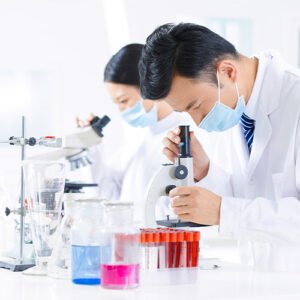Polyvinylidene difluoride (PVDF) has emerged as a prominent material in filtration applications, revolutionizing the way we purify liquids and gases. In this comprehensive guide, we will explore the myriad advantages that PVDF offers in the realm of filtration, shedding light on its exceptional properties and its role in enhancing efficiency and sustainability in various industries.
Entendiendo el PVDF
PVDF, or polyvinylidene difluoride, is a versatile thermoplastic polymer derived from vinylidene fluoride monomers. Its unique molecular structure comprises alternating CH2 and CF2 groups, resulting in an array of exceptional properties that make it an ideal choice for filtration applications.
The Chemistry of PVDF
PVDF is composed of carbon (C), hydrogen (H), and fluorine (F) atoms, represented by the chemical formula (C2H2F2)n. This arrangement of atoms gives rise to PVDF’s remarkable characteristics, making it a standout material in the world of filtration.
Key Advantages of PVDF in Filtration

PVDF’s distinct properties provide a multitude of advantages when it comes to filtration processes. Let’s explore these advantages in detail:
1. Resistencia química
PVDF exhibits outstanding resistance to a wide range of chemicals, including acids, bases, solvents, and corrosive substances. This resistance ensures that PVDF filtration systems remain robust and durable even in the harshest chemical environments.
2. Estabilidad térmica
With a high melting point of approximately 170°C (338°F) and the ability to maintain its structural integrity at temperatures up to 150°C (302°F), PVDF is well-suited for filtration processes involving high temperatures.
3. Fuerza mecánica
PVDF possesses excellent mechanical strength, making it resistant to wear and tear during filtration operations. This attribute ensures the longevity of filtration equipment and minimizes maintenance requirements.
4. Low Protein Binding
In applications involving biopharmaceuticals and food processing, PVDF’s low protein binding properties are highly advantageous. It prevents the adsorption of proteins onto filtration membranes, maintaining product purity and yield.
5. Hydrophobic Nature
PVDF is inherently hydrophobic, repelling water and promoting the easy passage of non-aqueous liquids and gases. This hydrophobicity is particularly beneficial in applications where water intrusion is undesirable.
6. Excellent Chemical Compatibility
The compatibility of PVDF with a wide range of chemicals and solvents makes it suitable for diverse filtration applications across various industries, from pharmaceuticals to petrochemicals.
7. Longevity and Durability
PVDF’s resistance to chemical degradation, UV radiation, and microbial growth contributes to the longevity and durability of filtration systems. This ensures consistent and reliable performance over time.
8. Ease of Cleaning and Sterilization
PVDF membranes are easy to clean and sterilize, making them suitable for applications requiring strict hygiene standards, such as food and beverage processing and pharmaceutical manufacturing.
Aplicaciones en todas las industrias

PVDF’s advantages in filtration have led to its widespread adoption in various industries. Here are some notable applications:
1. Pharmaceuticals and Biotechnology
PVDF membranes are extensively used in pharmaceutical and biotech industries for the filtration and purification of drugs, vaccines, and biopharmaceutical products.
2. Tratamiento de agua
PVDF’s resistance to chlorine and other disinfectants makes it an ideal choice for water filtration systems, including municipal water treatment and purification processes.
3. Food and Beverage
PVDF filtration ensures the removal of contaminants, microorganisms, and particles in the food and beverage industry, preserving product quality and safety.
4. Procesamiento químico
In chemical manufacturing, PVDF filtration systems play a crucial role in separating and purifying chemicals and solvents, contributing to product quality and process efficiency.
5. Electrónica
PVDF is used for the filtration of chemicals and solvents in semiconductor manufacturing, ensuring the cleanliness and integrity of electronic components.
6. Petróleo y gas
In the oil and gas industry, PVDF membranes are employed for the filtration of produced water, enhancing environmental sustainability and complying with regulatory requirements.
Preguntas frecuentes (FAQ)
Let’s address some common questions related to the use of PVDF in filtration applications:
Q1: Is PVDF membrane filtration suitable for sterile applications?
Yes, PVDF membranes can be sterilized and are commonly used in sterile filtration processes, such as in pharmaceutical manufacturing and biotechnology.
Q2: How does PVDF compare to other filtration materials like PTFE?
PVDF offers advantages such as chemical resistance, thermal stability, and low protein binding. While PTFE is also a suitable material for filtration, the choice between the two depends on specific application requirements.
Q3: Can PVDF membranes be used for filtering aggressive chemicals?
Yes, PVDF is highly resistant to aggressive chemicals and is suitable for filtering a wide range of corrosive substances in chemical processing applications.
Q4: What precautions should be taken when handling PVDF membranes?
When handling PVDF membranes, it’s essential to follow proper safety protocols, wear appropriate protective gear, and ensure a clean working environment to prevent contamination.
Q5: Are there sustainable aspects to using PVDF in filtration?
Yes, PVDF’s longevity, durability, and resistance to chemical degradation contribute to sustainable filtration processes, reducing the need for frequent membrane replacements and minimizing waste.
Conclusión
Polyvinylidene difluoride (PVDF) stands as a versatile and advantageous material in filtration applications. Its unique combination of properties, including chemical resistance, thermal stability, and low protein binding, make it an indispensable choice across various industries. From pharmaceuticals and water treatment to food and beverage processing, PVDF’s role in enhancing efficiency, purity, and sustainability in filtration processes is undeniable. As technology and innovation continue to advance, PVDF remains at the forefront of filtration solutions, ensuring the quality and safety of products and processes alike.


